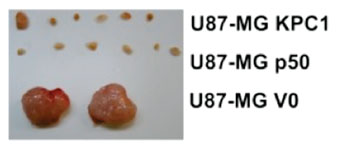Suppression of Tumor Growth Linked to Actions of the Ubiquitin System
By LabMedica International staff writers
Posted on 22 Apr 2015
Cancer researchers working with mouse xenograft and human cancer cell cultures have identified components of the ubiquitin system that are linked to certain cellular processes, which act to suppress malignant growth and protect healthy tissues.Posted on 22 Apr 2015
Ubiquitin is a small protein that exists in all eukaryotic cells. It performs myriad functions through conjugation to a large range of target proteins. The ubiquitin protein itself consists of 76 amino acids and has a molecular mass of about 8.5 kDa. Key features include its C-terminal tail and the seven lysine residues. It is highly conserved among eukaryotic species with human and yeast ubiquitin sharing 96% sequence identity. Ubiquitination is an enzymatic, protein post-translational modification (PTM) process in which the carboxylic acid of the terminal glycine from the di-glycine motif in the activated ubiquitin forms an amide bond to the epsilon amine of the lysine in the modified protein.
Investigators at the Technion-Israel Institute of Technology (Haifa, Israel) have focused on the protein KPC1 (Kip1 ubiquitylation-promoting complex 1), the catalytic subunit of the ubiquitin ligase KPC, and in particular on its relation to p105, a long precursor of the key cell regulator NF-kappaB.
The NF-kappaB (nuclear factor kappa-light-chain-enhancer of activated B cells) family of transcription factors comprises five structurally related proteins that form homo- and hetero-dimers through their highly conserved DNA binding/dimerization Rel homology domain. Binding of NF-kappaB to IkappaB proteins maintains NF-kappaB in an inactive state. Activation of NF-kappaB in normal cells is inducible and is a tightly controlled event. Upon stimulation, IkappaBs are phosphorylated by the IkappaB kinase (IKK) complex (consisting of IKK1, IKK2, and NEMO proteins). IkappaB phosphorylation leads to its rapid proteolysis, thereby allowing NF-kappaB to function as a transcription factor.
The investigators reported in the April 9, 2015, issue of the journal CELL that KPC1 ubiquitinated p105, resulting in the shortened protein p50. Working with mouse xenograft and human cancer cell cultures, they showed that high levels of KPC1 and p50 correlated with inhibition of tumor growth. Furthermore, KPC1 and p50 levels were lower in tumors than in normal tissue.
While these findings are of considerable importance in understanding molecular pathways that suppress cancer formation, senior author Nobel prize laureate Dr. Aaron Ciechanover, professor of biochemistry at the Technion-Israel Institute of Technology said, "Many more years are required to establish the research and gain a solid understanding of the mechanisms behind the suppression of the tumors. The development of a drug based on this discovery is a possibility, although not a certainty, and the road to such a drug is long and far from simple."
Related Links:
Technion-Israel Institute of Technology
















